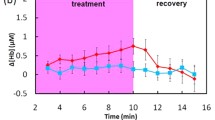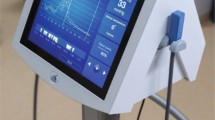Abstract
Exposure of biological tissue to photobiomodulation therapy (PBMT) seems to increase the oxygen availability and mitochondrial electrochemical activity. With the advancement of new technologies, such as near-infrared spectroscopy (NIRS), information can be obtained about the balance between oxygen utilization and delivery by assessing local oxy- ([O2Hb]) and deoxy-myohemoglobin ([HHb]) concentrations, both measured in micromolars (μM). Consequently, NIRS can be used to study (“in vivo”) PBMT effects on the oxidative system, including oxygen availability. Thus, the main objective of the present study was to use NIRS to investigate the acute effects of PBMT by light-emitting diode (LED) on the oxygen delivery and utilization in humans. Twelve healthy young participants were treated with a LED device (850 nm, 50 mW, 2 J) and placebo applied over the proximal third of the flexor carpi ulnaris muscle of the left or right forearm selected in a random order. The LED was applied in direct contact with skin and the device was switched on for 40 s in 4 different interventions (I1, I2, I3 and I4) with a 3-min interval between interventions. The placebo condition was considered as the period before the first PBMT. The NIRS device was used to evaluate the relative changes in [O2Hb] and [HHb] before and after placebo and interventions. We found that PBMT statistically increased the [O2Hb] in 0.39 μM. These results demonstrate the potential of PBMT to increase oxygen availability.





Similar content being viewed by others
Data availability
The dataset generated during the current study is available in the figshare® digital repository, https://figshare.com/articles/Linares_Dataset/7396085 or can be downloaded from the Dataset 1 file.
References
Ferraresi C, Huang YY, Hamblin MR (2016) Photobiomodulation in human muscle tissue: an advantage in sports performance? J Biophotonics 9(11–12):1273–1299. https://doi.org/10.1002/jbio.201600176
Ferraresi C, Kaippert B, Avci P, Huang YY, de Sousa MV, Bagnato VS, Parizotto NA, Hamblin MR (2015) Low-level laser (light) therapy increases mitochondrial membrane potential and ATP synthesis in C2C12 myotubes with a peak response at 3-6 h. Photochem Photobiol 91(2):411–416. https://doi.org/10.1111/php.12397
Ferraresi C, de Sousa MV, Huang YY, Bagnato VS, Parizotto NA, Hamblin MR (2015) Time response of increases in ATP and muscle resistance to fatigue after low-level laser (light) therapy (LLLT) in mice. Lasers Med Sci 30(4):1259–1267. https://doi.org/10.1007/s10103-015-1723-8
Karu T (1989) Photobiology of low-power laser effects. Health Phys 56(5):691–704
Francisco Cde O, Beltrame T, Ferraresi C, Parizotto NA, Bagnato VS, Borghi Silva A, Benze BG, Porta A, Catai AM (2015) Evaluation of acute effect of light-emitting diode (LED) phototherapy on muscle deoxygenation and pulmonary oxygen uptake kinetics in patients with diabetes mellitus: study protocol for a randomized controlled trial. Trials 16:572. https://doi.org/10.1186/s13063-015-1093-3
Wang X, Tian F, Reddy DD, Nalawade SS, Barrett DW, Gonzalez-Lima F, Liu H (2017) Up-regulation of cerebral cytochrome-c-oxidase and hemodynamics by transcranial infrared laser stimulation: a broadband near-infrared spectroscopy study. J Cereb Blood Flow Metab 37(12):3789–3802. https://doi.org/10.1177/0271678x17691783
Wang X, Tian F, Soni SS, Gonzalez-Lima F, Liu H (2016) Interplay between up-regulation of cytochrome-c-oxidase and hemoglobin oxygenation induced by near-infrared laser. Sci Rep 6:30540. https://doi.org/10.1038/srep30540
de Freitas LF, Hamblin MR (2016) Proposed mechanisms of photobiomodulation or low-level light therapy. IEEE J Sel Top Quantum Electron 22(3). https://doi.org/10.1109/jstqe.2016.2561201
Murias JM, Spencer MD, Paterson DH (2014) The critical role of O2 provision in the dynamic adjustment of oxidative phosphorylation. Exerc Sport Sci Rev 42(1):4–11. https://doi.org/10.1249/jes.0000000000000005
Beltrame T, Ferraresi C, Parizotto NA, Bagnato VS, Hughson RL (2018) Light-emitting diode therapy (photobiomodulation) effects on oxygen uptake and cardiac output dynamics during moderate exercise transitions: a randomized, crossover, double-blind, and placebo-controlled study. Lasers Med Sci. https://doi.org/10.1007/s10103-018-2473-1
Kubota J (2002) Effects of diode laser therapy on blood flow in axial pattern flaps in the rat model. Lasers Med Sci 17(3):146–153. https://doi.org/10.1007/s101030200024
Schindl A, Heinze G, Schindl M, Pernerstorfer-Schon H, Schindl L (2002) Systemic effects of low-intensity laser irradiation on skin microcirculation in patients with diabetic microangiopathy. Microvasc Res 64(2):240–246
Samoilova KA, Zhevago NA, Petrishchev NN, Zimin AA (2008) Role of nitric oxide in the visible light-induced rapid increase of human skin microcirculation at the local and systemic levels: II. Healthy volunteers. Photomed Laser Surg 26(5):443–449. https://doi.org/10.1089/pho.2007.2205
Ferraresi C, Hamblin MR, Parizotto NA (2012) Low-level laser (light) therapy (LLLT) on muscle tissue: performance, fatigue and repair benefited by the power of light. Photonics Lasers Med 1(4):267–286. https://doi.org/10.1515/plm-2012-0032
Barbosa R, Marcolino A, Souza V, Bertolino G, Fonseca M, Guirro R (2017) Effect of low-level laser therapy and strength training protocol on hand grip by dynamometry. Journal of lasers in medical sciences 8(3):112–117. https://doi.org/10.15171/jlms.2017.20
Jones S, Chiesa ST, Chaturvedi N, Hughes AD (2016) Recent developments in near-infrared spectroscopy (NIRS) for the assessment of local skeletal muscle microvascular function and capacity to utilise oxygen. Artery Res 16:25–33. https://doi.org/10.1016/j.artres.2016.09.001
Hughson RL (2009) Oxygen uptake kinetics: historical perspective and future directions. Appl Physiol Nutr Metab 34(5):840–850. https://doi.org/10.1139/h09-088
Ferreira LF, Townsend DK, Lutjemeier BJ, Barstow TJ (2005) Muscle capillary blood flow kinetics estimated from pulmonary O2 uptake and near-infrared spectroscopy. J Appl Physiol 98(5):1820–1828. https://doi.org/10.1152/japplphysiol.00907.2004
Maegawa Y, Itoh T, Hosokawa T, Yaegashi K, Nishi M (2000) Effects of near-infrared low-level laser irradiation on microcirculation. Lasers Surg Med 27(5):427–437. https://doi.org/10.1002/1096-9101(2000)27:5<427::aid-lsm1004>3.0.co;2-a
Ihsan FR (2005) Low-level laser therapy accelerates collateral circulation and enhances microcirculation. Photomed Laser Surg 23(3):289–294. https://doi.org/10.1089/pho.2005.23.289
Boushel R, Langberg H, Olesen J, Gonzales-Alonzo J, Bulow J, Kjaer M (2001) Monitoring tissue oxygen availability with near infrared spectroscopy (NIRS) in health and disease. Scand J Med Sci Sports 11(4):213–222
Grassi B, Quaresima V (2016) Near-infrared spectroscopy and skeletal muscle oxidative function in vivo in health and disease: a review from an exercise physiology perspective. J Biomed Opt 21(9):091313. https://doi.org/10.1117/1.jbo.21.9.091313
Puente-Maestu L, Tena T, Trascasa C, Perez-Parra J, Godoy R, Garcia MJ, Stringer WW (2003) Training improves muscle oxidative capacity and oxygenation recovery kinetics in patients with chronic obstructive pulmonary disease. Eur J Appl Physiol 88(6):580–587. https://doi.org/10.1007/s00421-002-0743-9
Obesity: preventing and managing the global epidemic. Report of a WHO consultation (2000) World Health Organization technical report series 894:i–xii, 1–253
Van Beekvelt MC, Colier WN, Wevers RA, Van Engelen BG (2001) Performance of near-infrared spectroscopy in measuring local O(2) consumption and blood flow in skeletal muscle. J Appl Physiol 90(2):511–519. https://doi.org/10.1152/jappl.2001.90.2.511
Ghasemi A, Zahediasl S (2012) Normality tests for statistical analysis: a guide for non-statisticians. Int J Endocrinol Metab 10(2):486–489. https://doi.org/10.5812/ijem.3505
Imeson JD, Haines AP, Meade TW (1989) Skinfold thickness, body mass index and ischaemic heart disease. J Epidemiol Community Health 43(3):223–227. https://doi.org/10.1136/jech.43.3.223
Celie B, Boone J, Van Coster R, Bourgois J (2012) Reliability of near infrared spectroscopy (NIRS) for measuring forearm oxygenation during incremental handgrip exercise. Eur J Appl Physiol 112(6):2369–2374. https://doi.org/10.1007/s00421-011-2183-x
Crenshaw AG, Elcadi GH, Hellstrom F, Mathiassen SE (2012) Reliability of near-infrared spectroscopy for measuring forearm and shoulder oxygenation in healthy males and females. Eur J Appl Physiol 112(7):2703–2715. https://doi.org/10.1007/s00421-011-2244-1
Miranda EF, Leal-Junior EC, Marchetti PH, Dal Corso S (2014) Acute effects of light emitting diodes therapy (LEDT) in muscle function during isometric exercise in patients with chronic obstructive pulmonary disease: preliminary results of a randomized controlled trial. Lasers Med Sci 29(1):359–365. https://doi.org/10.1007/s10103-013-1359-5
Hayworth CR, Rojas JC, Padilla E, Holmes GM, Sheridan EC, Gonzalez-Lima F (2010) In vivo low-level light therapy increases cytochrome oxidase in skeletal muscle. Photochem Photobiol 86(3):673–680. https://doi.org/10.1111/j.1751-1097.2010.00732.x
DeLorey DS, Kowalchuk JM, Paterson DH (2003) Relationship between pulmonary O2 uptake kinetics and muscle deoxygenation during moderate-intensity exercise. J Appl Physiol 95(1):113–120. https://doi.org/10.1152/japplphysiol.00956.2002
Beltrame T, Villar R, Hughson RL (2017) Sex differences in the oxygen delivery, extraction, and uptake during moderate-walking exercise transition. Appl Physiol Nutr Metab 42(9):994–1000. https://doi.org/10.1139/apnm-2017-0097
Ferraresi C, Beltrame T, Fabrizzi F, do Nascimento ES, Karsten M, Francisco Cde O, Borghi-Silva A, Catai AM, Cardoso DR, Ferreira AG, Hamblin MR, Bagnato VS, Parizotto NA (2015) Muscular pre-conditioning using light-emitting diode therapy (LEDT) for high-intensity exercise: a randomized double-blind placebo-controlled trial with a single elite runner. Physiother Theory Pract 31(5):354–361. https://doi.org/10.3109/09593985.2014.1003118
Financial support
This study was financed in part by Coordenação de Aperfeiçoamento de Pessoal de Nível Superior, Brazil - CAPES (Code 001) to SNL; by São Paulo State Research Foundation - FAPESP (grant 2013/07953-3 to AMC, and 2017/09639-5 and 2018/19016-8 to TB), and by National Council for Scientific and Technological Development – CNPq (grant 311938/2013-2) to AMC. The funders had no role in study design, data collection and analysis, decision to publish, or preparation of the manuscript.
Author information
Authors and Affiliations
Corresponding author
Ethics declarations
Conflict of interest
The authors declare that they have no conflict of interest.
Additional information
Publisher’s note
Springer Nature remains neutral with regard to jurisdictional claims in published maps and institutional affiliations.
Electronic supplementary material
ESM 1
(CSV 480 kb)
Rights and permissions
About this article
Cite this article
Linares, S.N., Beltrame, T., Ferraresi, C. et al. Photobiomodulation effect on local hemoglobin concentration assessed by near-infrared spectroscopy in humans. Lasers Med Sci 35, 641–649 (2020). https://doi.org/10.1007/s10103-019-02861-x
Received:
Accepted:
Published:
Issue Date:
DOI: https://doi.org/10.1007/s10103-019-02861-x




